The making of a prehistoric IKEA bag, Part 1
Ever wonder how people survived before the invention of those giant bags from IKEA? Apparently the answer is, they made their own! Christina Pappas shows us how it was done in this two-part post, starting today!

One of the bags we’re studying for replication. This was a large tote-style bag, much like the kind you can find at Ikea! Image courtesy the William S. Webb Museum of Anthropology, University of Kentucky.
When we last met, we took a long look at the slippers I’ll be replicating for this project. This week, we’ll be getting to know the bags. Have a look at my last couple of posts to learn about this project and the slippers I’m making:
- Following in the Steps of a 2,000 year old spinner
- How to make a 2,000 year old slipper (part 1)
- The Accidental Textile Archaelogist
Pop culture likes to show archaeology with artifacts that are intact and spectacular. Man, I wish that was how it really worked. I don’t think the Indiana Jones franchise would have been as successful if they showed Indy and his students during their summer field school carefully mapping individual pieces of stone tool debris. No, golden statues and gigantic rolling boulders are far more fun.
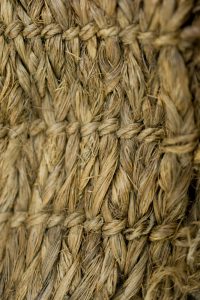
Braided warps give us both strength and flexibility for carrying bags. Image courtesy the William S. Webb Museum of Anthropology, University of Kentucky.
That’s sometimes how it feels when you’re a textile archaeologist. People imagine ancient Egyptian tombs or Chinese silks, but that’s rarely the case. The southeastern US, where I work, is not suited to preserving organic materials like fabric. When we find the fragments of ancient culture we must work to carefully piece them together to tell the story of our distant ancestors. It’s hard work, and finding a complete object is rare.
For the bag we’re going to try to replicate, we have to look at multiple different bags to figure out how to make one. That’s because we don’t have a complete bag and we need to piece together the different parts. All the objects we’ll be looking at today are in the collection of the William S. Webb Museum of Anthropology at the University of Kentucky.
The Webb Museum has several prehistoric bags from Kentucky. They are in varying degrees of completeness, but combined can help show us how a bag was constructed. We’re going to look specifically at two bags from one rockshelter, Newt Kash Hollow. We think they’re close in age to one another, and were made in a similar way to one another.

Rattlesnake Master plant – once the plant starts to die back for the winter, it’s time to harvest the leaves for fiber. Image from Wikimedia.org.
The first thing I notice when looking at these bags is that their warps aren’t spun – they’re braided! These bags appear to be made from a native grass called Rattlesnake Master (Eryngium yuccifolium). This grass makes for a hard-wearing yarn, but when processed into a 3-ply braid, it seems to be more flexible yet able to retain its strength. Perhaps that’s why the ancient Native peoples choose to braid their warp rather than spin it? They could make a strong yet flexible warp for a bag that could bend and support a heavy load. These warps are pretty thick, averaging about 1 ½ warps per centimeter and each about 0.6 cm (0.23 in) in diameter. The grass was well shredded before it was braided.
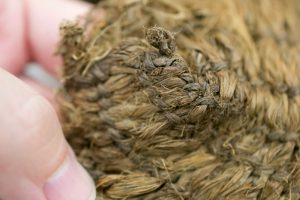
This knot is where the weaving ended. The twining was begun at the outter edge of the bag and twined around till you reached the bottom. Image courtesy the William S. Webb Museum of Anthropology, University of Kentucky.
The wefts are made from a plied yarn, two Z-spun singles S-plied together. It’s much thinner than the braided warps, averaging about 0.3 cm (0.11 in) in diameter. I’m not sure if the wefts are also made of Rattlesnake Master. They are much thinner and more finely shredded than our braided warps. I will probably need to experiment with the Rattlesnake Master to see if I can make a yarn that fine. The weft rows are pretty far apart so measuring wefts/centimeter won’t help us much here. Each weft row is made up of two yarns twining around the warps. The wefts twine around individual warps near the edges and bottom of the bag but around pairs of warps in the body. This is probably to give additional strength and stability to the edge and bottom of the bag while keeping the sides flexible.
The tops of the bags are a bit different from one another. The edge of one bag was made by folding and twisting pairs of braided warps around a cord which then became a drawstring for closing the bag. The other bag had individual warps folding and twisting around a cord, but the cord was a part of a finished edge, almost like knitted i-cord, that went around the entire edge. Thickly twisted 2-ply yarns were tied along the edge to act as handles. The handles on this bag would have allowed it act much like the large tote bags you can get at Ikea. It was probably just a big – the warps each measured over a meter in length.
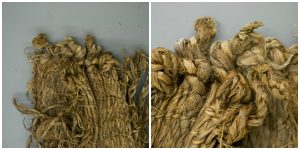
The top of our drawstring bag and a close-up showing how the cord was looped through the top of the bag. Images courtesy the William S. Webb Museum of Anthropology, University of Kentucky.
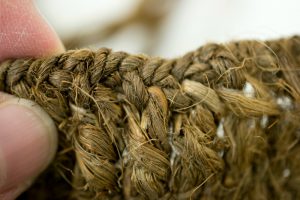
The top edge of the our tote bag. See how the finished edge acts like i-cord for knitting? Image courtesy the William S. Webb Museum of Anthropology, University of Kentucky.
So what do we know so far?
I’ll need to find some Rattlesnake Master and process it so I can make 3-ply braids for the warps. My bag will be much smaller than either of these bags to keep this project manageable and to make sure I can find enough Rattlesnake Master. I will also need to make the 2-ply yarn for the weft and for the edging. I’m not sure those were made from Rattlesnake Master so I’ll have to do some additional research and experimentation.
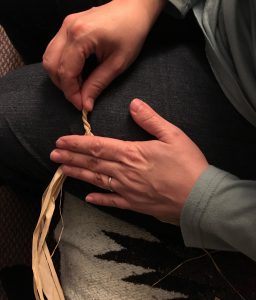
Practicing my thigh spinning. It has been a long time since I tried to make yarn this way and I’ll need the practice for this project. Rafia grass, readily available at most craft stores, is the prefect material for practice.
Our next step in this journey is to collect and process our plants for fiber and then the real fun begins: spinning and weaving! I’ve been experimenting with two different ways to spin my fiber – thigh spinning and finger twisting. It seems like there’s always something new and different to learn.
Till next time!

Chris Pappas is an archaeologist by day and a fiber fanatic by night who is happiest when she can be both at the same time. She lives in Kentucky with her husband, adorable baby girl, and two crazy beagles.




That is fascinating! Were these bags found in the same caves as the shoes you looked at in your previous articles? Also, do you know how the materials were processed? Did they really just shred the leaves, or did they have to go through some sort of retting process like flax? Now I want to start twisting leaves together whenever I see them!
I was just in NZ where thigh spinning and twinning is still taught as a Maori skill for robes and utilitarian items.
PatsyZ